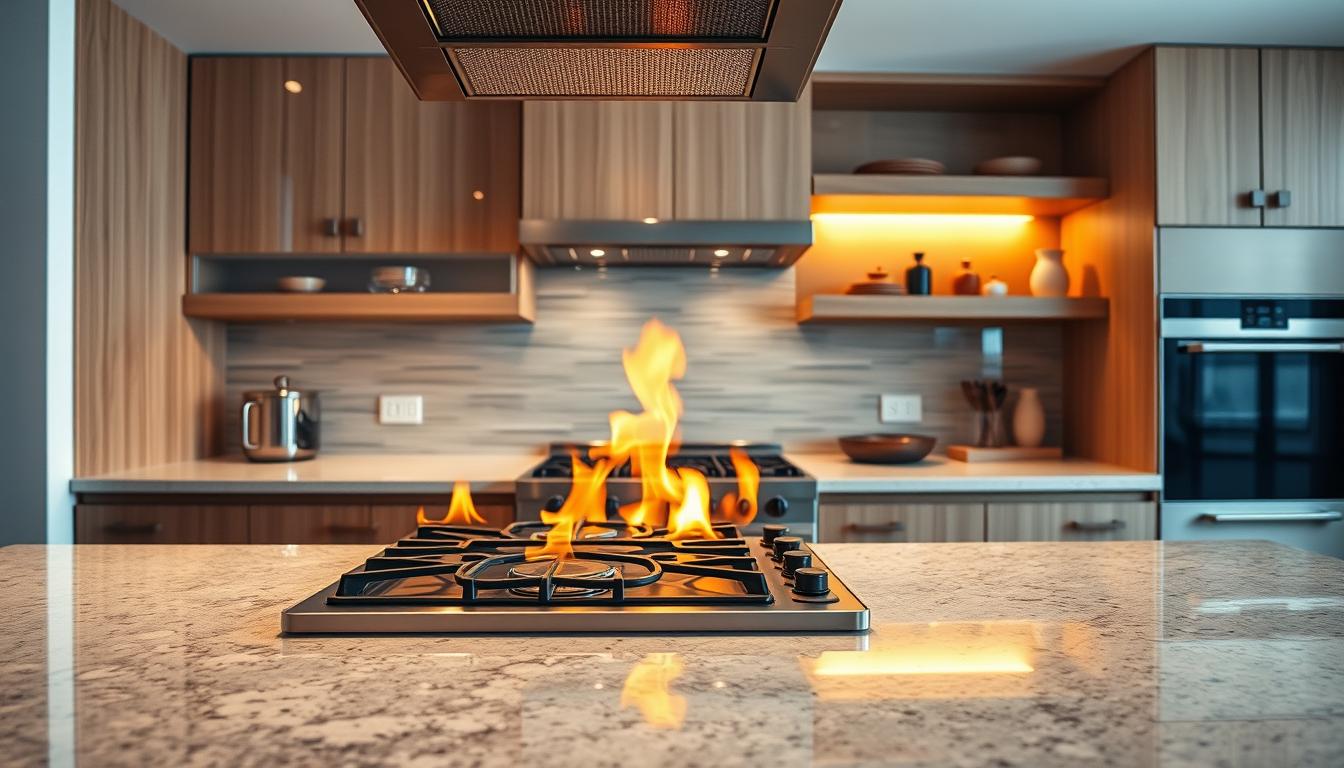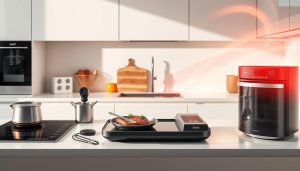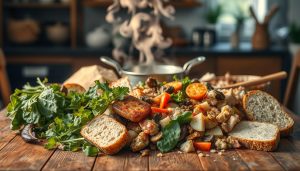An estimated 374,000 American households experience fires yearly, with kitchens ranking among the most vulnerable areas due to constant heat exposure. What most people overlook is that their cooking spaces already contain built-in defenses against this threat.
Common surfaces and tools in food preparation zones often include heat-resistant components designed to withstand high temperatures. Countertops, cabinet linings, and even appliance coatings frequently incorporate substances that slow flame spread during emergencies. These features aren’t accidents – they’re intentional safety measures meeting strict building codes.
Recognizing these protective elements helps homeowners enhance their space’s security without compromising style. Modern design standards prioritize both visual appeal and practical safeguards, blending seamlessly into daily life. This article explores how standard kitchen features provide passive protection and how to optimize their effectiveness.
Key Takeaways
- Standard cooking areas contain multiple flame-slowing components
- Many countertops and cabinets meet strict fire-resistance ratings
- Material choices during renovations impact safety outcomes
- Building codes mandate specific protective features in kitchens
- Proper maintenance enhances inherent fire-resistant properties
Understanding Fire-Resistant Materials in Your Home
Many household surfaces and tools serve dual purposes – practical functionality and hidden safety features. Fire resistance isn’t just for industrial settings. Your living spaces contain carefully selected components that protect against thermal risks while blending into daily life.
What Defines Fire Resistance?
A material’s protective ability depends on four factors: ignition threshold, flame spread speed, smoke production, and structural stability under extreme heat. Organizations like UL and NFPA test products using torches reaching 1,800°F and measure how long they resist burning through.

Everyday Items with Protective Qualities
Common kitchen elements often exceed basic safety requirements. Ceramic backsplashes withstand direct contact with stovetop flames for 30+ minutes. Stainless steel appliances maintain integrity at 1,400°F – hotter than most cooking fires.
| Material | Ignition Temperature | Flame Spread Rating | Common Uses |
|---|---|---|---|
| Ceramic Tile | 2,200°F | Class A (0-25) | Countertops, floors |
| Borosilicate Glass | 900°F | Non-combustible | Oven doors, cookware |
| Galvanized Steel | 1,600°F | Class I (25-75) | Vent hoods, cabinets |
Building codes require specific flame-retardant treatments for cabinet liners and insulation behind walls. These hidden layers slow fire progression, giving occupants crucial escape time during emergencies.
Exploring Fireproof Materials You Didn’t Know Were in Your Kitchen
Modern cooking spaces contain multiple elements that act as silent guardians against thermal hazards. While stainless steel appliances and stone surfaces serve obvious purposes, their protective qualities often go unnoticed until emergencies occur.

Unexpected Heat-Defying Elements
Granite countertops withstand temperatures exceeding 1,200°F without cracking – hotter than most oven settings. This natural stone’s density prevents heat penetration, creating a barrier between flames and flammable cabinet materials.
Glass cooktops demonstrate surprising resilience through tempered manufacturing processes. These surfaces undergo rapid cooling treatments that increase structural stability under thermal stress. When paired with stainless steel cookware, they form a heat-resistant cooking system.
| Component | Max Temperature Resistance | Safety Benefit |
|---|---|---|
| Quartz Countertops | 1,500°F | Non-combustible surface |
| Borosilicate Glass | 900°F | Flame containment |
| Galvanized Cabinet Frames | 1,200°F | Delays structural collapse |
Integrated Defense Mechanisms
Metal drawer slides and hinges maintain functionality during extreme heat exposure. Unlike plastic alternatives, these components won’t melt or warp, keeping escape routes accessible.
Ceramic wall tiles act as thermal breaks between cooking surfaces and drywall. Their kiln-fired composition resists ignition while reflecting radiant heat away from vulnerable areas. Combined with stone flooring, these features create multiple fire-slowing layers throughout the space.
“Proper material selection transforms ordinary kitchens into layered defense systems against thermal emergencies.”
Understanding Fire Resistance Ratings
Safety standards transform abstract risks into measurable safeguards. Two organizations shape residential fire safety: Underwriters Laboratories (UL) and the National Fire Protection Association (NFPA). Their testing protocols determine which materials slow flames effectively in real-world scenarios.

UL and NFPA Standards Explained
UL evaluates materials using controlled flame exposure lasting 30+ minutes. Their fire protection ratings measure three factors: ignition resistance, structural stability, and smoke suppression. Countertops scoring Class 1 (0-25 flame spread) outperform wood panels by 400% in containment tests.
The National Fire Protection Association focuses on system-wide safety. NFPA 255 tests simulate entire wall assemblies under fire conditions. This reveals how materials interact during emergencies – crucial for predicting real-world performance.
| Rating System | Test Method | Key Metrics | Home Application |
|---|---|---|---|
| UL 723 | Surface flammability | Smoke developed index | Cabinet liners |
| NFPA 255 | Full wall assembly | Flame spread duration | Backsplash systems |
| ASTM E84 | Tunnel test | Comparative burn rate | Flooring materials |
Interpreting Ratings for Home Applications
Look for dual certifications when selecting countertops or insulation. A UL Class A/NFPA 255-compliant backsplash provides 55% longer containment than single-rated options. These labels matter most in high-heat zones near ovens and cooktops.
Building codes often reference fire protection association standards for good reason. Materials meeting both UL and NFPA requirements typically withstand 1,200°F+ temperatures for 45 minutes – enough time for emergency response. Always verify certifications match your local code’s version year.
“Third-party ratings remove guesswork from material selection. They’re your blueprint for layered fire defense.”
Installation Considerations for Fire-Resistant Backsplashes
Proper installation transforms fire-resistant materials into reliable safeguards. Even premium components underperform without correct anchoring and spacing techniques. This process demands equal attention to technical specifications and regional safety regulations.

Choosing the Right Materials and Techniques
Heat-resistant adhesives prove essential for maintaining structural integrity. Standard tile glue degrades above 200°F, while specialized epoxy withstands 1,000°F. Always verify product labels for temperature ratings matching your cooking appliances.
Tempered glass requires precise expansion gaps during installation. These 1/8-inch spaces prevent thermal stress fractures as surfaces heat and cool. Pair with non-combustible cement board backing for optimal protection.
| Material | Required Adhesive | Expansion Gap | Code Reference |
|---|---|---|---|
| Tempered Glass | Silicone-based | 1/8 inch | IRC R702.4 |
| Ceramic Tile | Heat-resistant mortar | 1/16 inch | NFPA 255 |
| Stainless Steel | Mechanical fasteners | N/A | UL 1479 |
Compliance with Local Building Codes
Most jurisdictions mandate 6-inch clearance between backsplashes and cooktops. Some regions require additional heat shields for gas ranges. Always secure permits before modifying walls or electrical systems.
Professional installers often provide documentation confirming code adherence. This paperwork becomes crucial during home inspections or insurance claims. Remember – building standards update regularly. Verify current requirements with municipal offices.
“A correctly installed fire-resistant backsplash acts like a thermal firewall – but only when materials and methods align with local realities.”
Aesthetic Options for a Fire-Safe Kitchen
Creating a safe cooking space doesn’t require sacrificing visual appeal. Modern fire-resistant materials blend seamlessly with trending design styles, offering both protection and personality. From glossy surfaces to textured finishes, these elements prove safety features can enhance a room’s character.

Style Meets Protection
Glass backsplashes demonstrate how functionality pairs with elegance. Available in frosted, tinted, or patterned options, they resist heat while amplifying natural light. Their non-porous surfaces simplify cleaning—a practical bonus for busy households.
Natural stone choices like quartzite or soapstone deliver earthy textures with built-in thermal resistance. These materials withstand accidental pan contact without scorching, maintaining their polished appearance through years of use.
For industrial flair, consider metal accents. Brushed stainless steel panels or hammered copper tiles create focal points near cooking zones. Their reflective properties help dissipate heat, adding an extra layer of protection.
“The best kitchen designs solve problems quietly. Fire-safe surfaces should protect without shouting ‘safety feature’.”
Color options abound in flame-resistant materials. Ceramic tiles now come in bold geometric patterns, while tempered glass offers gradient effects. These choices let homeowners express personal taste without compromising their kitchen’s defensive capabilities.
Maintenance and Durability of Fire-Resistant Materials
Maintaining fire-resistant surfaces ensures they perform optimally over years of use. Proper care preserves both safety features and visual appeal, creating lasting value in high-heat environments.

Effective Cleaning Strategies
Ceramic and porcelain tiles thrive with basic care. Wipe them weekly with mild soap and water – their non-porous surfaces repel stains without harsh chemicals. For grease splatters near cooking zones, use baking soda paste for gentle abrasion.
Stainless steel maintains its protective qualities through regular polishing. Microfiber cloths prevent scratches while removing fingerprints. Avoid chlorine-based cleaners that degrade surface treatments over time.
| Material | Cleaning Method | Maintenance Frequency | Cost Savings |
|---|---|---|---|
| Ceramic Tile | Mild detergent | Weekly | 30% vs. replacements |
| Stainless Steel | Specialized polish | Bi-weekly | 45% lifespan increase |
| Tempered Glass | Vinegar solution | Monthly | 60% durability boost |
| Natural Stone | pH-neutral cleaner | Quarterly sealing | 50% stain reduction |
Maximizing Material Lifespan
Glass surfaces retain heat resistance indefinitely when cleaned with vinegar solutions. These acidic mixtures dissolve mineral deposits without etching the surface. Always dry thoroughly to prevent water spots.
Natural stone requires more attention – seal it annually with penetrating treatments. This prevents moisture absorption while maintaining fire-resistant properties. Quartz countertops need only daily wiping, offering low-effort protection.
“Consistent care turns fire-resistant features into lifelong safeguards. Simple routines yield exponential safety returns.”
Durable materials like galvanized steel and borosilicate glass reduce replacement costs by 40-60%. Their initial investment pays off through decades of reliable performance, making them smart choices for budget-conscious upgrades.
Additional Fire Safety Enhancements for Your Home
Protecting living spaces requires strategic upgrades beyond cooking areas. Modern building materials and design choices create multiple defense layers against flames. These enhancements work together to slow fire spread and provide critical evacuation time.
Critical Structural Upgrades
Fire-stopping materials at wall top plates block flames from reaching attics. This simple measure prevents rapid vertical spread through hidden spaces. Code-compliant installations use mineral wool or fire-rated foam to seal gaps.
Consider these essential upgrades for comprehensive protection:
- Double-pane windows with tempered glass resist heat transfer 50% longer than single-pane versions
- Solid-core doors (1-3/8″ thick) between garages and living areas meet fire-separation requirements
- Class A roofing materials like metal or treated asphalt shingles withstand ember showers
“A home’s fire resistance depends on its weakest link. Strategic upgrades transform vulnerable points into protective barriers.”
| Roof Type | Fire Rating | Lifespan |
|---|---|---|
| Metal | Class A | 40-70 years |
| Clay Tile | Class A | 100+ years |
| Treated Asphalt | Class A | 20-30 years |
Drywall installations in garages add 15-30 minutes of fire containment. Pair with smoke detectors in adjacent rooms for early warning. Regular inspections ensure materials maintain their protective qualities over time.
Conclusion
Every home holds hidden defenses against fire risks, often overlooked in daily life. Common surfaces like ceramic tiles and metal fixtures serve as silent guardians, slowing flames while blending into your space. Recognizing these built-in protections helps maximize their effectiveness through smart maintenance and design choices.
Knowledge of fire-resistant properties empowers safer renovations. Whether updating countertops or selecting appliances, prioritize materials with proven heat tolerance. Pair these elements with smoke detectors and escape plans for layered safety systems.
Regular care preserves both appearance and protective qualities. Simple routines—like sealing stone surfaces or polishing steel—extend material lifespans while maintaining fire ratings. These efforts create lasting shields against thermal threats.
Balancing practicality and style remains achievable. Modern fire-safe options range from industrial metal accents to sleek glass finishes, proving protection doesn’t require aesthetic compromise. Thoughtful material selection ultimately builds spaces that safeguard families without sacrificing comfort.



